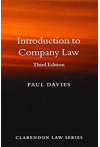- Author(s): Paul Davies
- Publisher: Oxford University Press
- Edition: 3 Rd 2020, 2 Impression
- ISBN 13 9780198854920
- Approx. Pages 360 + Contents
- Format Paperback
- Approx. Product Size 21 x 14 cms
- Delivery Time 3-5 working days (within Kerala & South India) (Others 7-9 days)
- Shipping Charge Extra (see Shopping Cart)
............................................................................................
Description
The second edition of this book appeared in 2010 and the first edition in 2002. Between the first and second editions there was a major statutory restatement of United Kingdom company law in the Companies Act 2006. That provided by itself a sufficient reason for a new edition. Although a longer period has elapsed since the second edition than between the first and the second, this is not necessarily enough to justify a third edition. The aim of the book is to provide a high-level analysis of the basic features of United Kingdom company law. To the extent that this goal was achieved in the second edition, the mere lapse of time does not make the case for a third edition. Of course, over the past decade both the courts and the legislature have added to the body of company law in incremental ways and I have taken these changes into account where they are relevant. However, something more fundamental has driven the third edition. First, when I wrote the second edition, I was in the process of moving from the London School of Economics back to Oxford. For the past decade I have been teaching comparative corporate law in Oxford. In this process I have learned a lot from my colleagues, notably John Armour, Luca Enriques, and Georg Ringe (now in Hamburg), and also from the twenty or so intelligent, articulate, committed, and jurisdictionally diverse students who took this course each year. They helped me to make more sophisticated my understanding of the concepts discussed in the second edition. I hope that that greater sophistication reveals itself in this third edition. The second significant event was one that was occurring as I was preparing the second edition, but whose significance for company law became clear only in the following years. This was the financial crisis of 2007-09, whose immediate legal impact was on financial regulation, which was almost revolutionized. However, it subsequently became clear that the crisis had sparked a more widespread scepticism about the operation of markets and the value of private ordering. This was bound to have and did have an impact on company law.
............................................................................................
Table of Contents
1: Introduction
What Is Company Law And What Does It Do?
Establishing A Basic Structure
Constituting Ongoing Relations Within
The Company
Which relationships concern company law?
Shareholders
Directors And Senior Managers
Lenders
The Overall Picture
Sources Of Corporate Law And Types
Of Company
The Structure Of The Book
2: The Board
The Allocation Of Functions Between The
Shareholders And The Board
The Allocation Of Managerial Powers Between
The Board And Senior Management
Composition Of The Board
Acting For Whom?
Conclusion
3: Governance And The Shareholders As A Class
Shareholder Decisions
Mandatory Shareholder Approval
Shareholder-Initiated Shareholder Approval
Appointment Rights
Shareholder Engagement
Shareholder Structure
Governmental Pressure On Institutions
To Engage
The Stewardship Code 2012
Private Incentives To Engage
Public Incentives
Amendments To The Shareholder Rights
Directive And The Sc 2020
Activist Hedge Funds
Conclusion
4: Markets And The Shareholders As A Class
Executive Pay
Remuneration Committees And The CGC
Shareholder 'Say On Pay'
Specific Shareholder Approval Requirements
The Market For Corporate Control
Private Incentives To Engage
Public Incentives
Amendments To The Shareholder Rights
Directive And The Sc 2020
Activist Hedge Funds
Conclusion
5: Majority And Minority Shareholders
The Benefits And Costs Of Controlling
Shareholders
Facilitating
Disclosure Requirements
Exit Rights
Disclosure Requirements
Structuring The Decision-Maker
Substantive Review
Structuring The Decision-Maker
Conclusion
Unfair Prejudice
Winding Up On The Just And Equitable Ground
Multiple Legal Strategies
Control-Enhancing Mechanisms
Conclusion
6: Directors' Duties
Introduction
Duty Of Care
Fiduciary Duties
Duty To Act Within Powers
Duty To Exercise Independent Judgment
Conflicts Of Interest
Self-Dealing Transactions
Corporate Opportunities And Other
Conflicts Of Interest
Duty Not To Accept Benefits From Third Parties
Competing Directors
Shaping The Duties
Conclusion
7: Creditors
Creditor Interests In The Company
Transactional Invalidity, Standards
And Rules In The Vicinity Of Insolvency
Creditor Protection In Going Concerns
Conclusion
8: Liability And Enforcement
Civil Liability
Appropriate Enforcers
Dispute Settlement And The Costs Of Lit
Criminal Liability
Liability Enforcers And Dispute Settle
Regulatory Breaches
Conclusion
9: The Social Function Of Corporate Law
The Argument For Shareholder-Oriented
Company Law
Criticism Of The Theory
Inducing Operational Efficiency
Corporate Disclosure
Duties Of Financial Intermediaries
Compliance
More Radical Critiques
............................................................................................
Author Details
Paul Davies Q C, FBA, Senior Reaserch Fellow Centre for Commercial Law Harris
Manchester College University of Oxford

